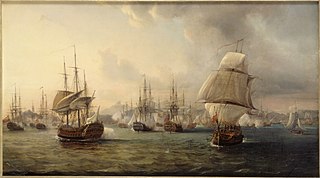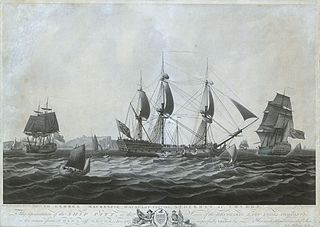
The Battle of Porto Praya was a naval battle that took place during the American Revolutionary War on 16 April 1781 between a British squadron under Commodore George Johnstone and a French squadron under the Bailli de Suffren.
HMS Albemarle was a 28-gun sixth rate frigate of the Royal Navy. She had been built as the French merchantman Ménagère, which the French Navy purchased in 1779. A British squadron captured her in September and she was commissioned into service with the Royal Navy. Amongst her commanders in her short career was Captain Horatio Nelson, who would later win several famous victories over the French. The Navy sold her in 1784. She subsequently became a merchant vessel again. In 1791 she transported convicts to Port Jackson as part of the third fleet. She then sailed to India where she picked up a cargo on behalf of the British East India Company. As she was returning to England a French privateer captured her.

Fortitude was a merchant vessel built in 1780 on the River Thames. A French frigate captured her in 1782 while she was on the return leg of her maiden voyage to India as an East Indiaman for the British East India Company (EIC). However, the British recaptured her in October 1782. The EIC purchased her and sent her back to England. There, in 1785, George Macartney Macauley purchased her and renamed her Pitt. She then performed five voyages for the British East India Company (EIC) between 1786 and 1798. In between, she made one journey transporting convicts from England to New South Wales. She was broken up in 1801.
Pigot was an East Indiaman that made five voyages to India, China, and the East Indies for the British East India Company (EIC) between 1780 and 1794. Oh her fifth voyage, which occurred early in the French Revolutionary Wars, the French captured her during the Sunda Strait campaign of 1794.

Swallow was a teak-built packet ship that the British East India Company (EIC) launched at Bombay in 1779. She made nine trips between India and Britain for the EIC between 1782 and 1803. Her most notable exploit occurred on her seventh voyage, when she helped capture seven Dutch East Indiamen on 15 June 1795. The Royal Navy purchased her in 1804 and named her Lilly. She served in the navy until she was sold in 1811. During this time she participated in the capture of La Désirade island, and participated in a quixotic and unsuccessful attempt of General Francisco de Miranda to liberate the Province of Venezuela from Spain in 1806. Her whereabouts between 1811 and 1815 are obscure, but in 1815 J. Lyney, of London, purchased her and she sailed to the West Indies and to India as an EIC-licensed vessel until she wrecked on her way to Calcutta in 1823.
Osterley was a three-decker East Indiaman, launched in 1780, that made seven trips for the British East India Company between 1781 and 1800. She was present at two battles, and an engagement in which four Indiamen and a country ship engaged a French frigate. On her last trip a French frigate captured her in a single-ship action, but sent her on her way. Osterley eventually returned to Britain in 1800. Her subsequent fate is unknown.
Chapman was a two-deck merchant ship built at Whitby in 1777. She made three voyages to India or China for the British East India Company (EIC), during the first of which she was present at the battle of Porto Praya. During the French Revolutionary Wars she served as a hired armed ship, primarily escorting convoys but also seeing some action. Later, she undertook one voyage to Mauritius transporting troops, one voyage carrying settlers to South Africa, and three voyages transporting convicts from England and Ireland to Australia. She was last listed in 1853.
Locko was originally the French East Indiaman Modeste, built in France. The Royal Navy captured Modeste in 1778, while she was on the return leg of her maiden voyage, whereupon individuals associated with the British East India Company (EIC) purchased her. She entered the EIC's service in 1780, then performed three voyages for the EIC. On the first voyage she was present at the Battle of Porto Praya, and led an inconclusive attack by five merchant vessels on a French frigate. The second and third voyages were much less eventful. Locko's owners disposed of her on her return in 1788 from her third voyage.

Ceylon was an East Indiaman launched in 1803. She performed four voyages for the British East India Company (EIC). On her fourth voyage the French captured her in the action of 3 July 1810; she then took part in the Battle of Grand Port. The British recaptured her at the invasion of Île de France. She completed her fourth voyage and her owners then sold her. She became a transport until her owners sold her in 1815 to new foreign owners.
Asia was launched in 1780 and made six voyages as an East Indiaman for the British East India Company (EIC). She participated in three actions, two against the French and one against the Dutch. She left the EIC's service in 1799 and traded between London and Lisbon until 1802 when new owners from Embden renamed her Reine Louise de Prusse and returned her to trading with the East Indies. Asia is last listed in Lloyd's Register for 1808 on the London-Batavia trade.

Northumberland was launched in 1780 to serve as a regular ship of the British East India Company (EIC). She made six voyages for the EIC between 1780 and 1797. She was sold in 1797 for breaking up.
Britannia was launched by the Bombay Dockyard in 1772, and was rebuilt in 1778. The British East India Company (EIC) apparently acquired her in 1775. Between 1779 she made eleven complete voyages as an East Indiaman for the EIC. She also participated in three naval campaigns, during the first of which she was deployed as a cruiser off Sumatra. There she engaged and captured a French ship. In the other two she served as a transport. She set out for her twelfth EIC voyage but was lost in 1805 during the third naval campaign.

Essex was launched in 1780 as an East Indiaman. She made six voyages for the British East India Company (EIC). On her first voyage she was present at an inconclusive battle with the French, and later at a second inconclusive engagement with a French frigate. In 1798 she was sold to be hulked or broken up.
Valentine was launched in 1780 as an East Indiaman. She made six voyages for the British East India Company (EIC), and was a transport for one military campaign. On her first voyage she was present at an inconclusive battle with the French, but did not take an active part. She was sold in 1796 for breaking up.
Mulgrave Castle was launched in 1813 at Scarborough and spent much of her career sailing between England and India under a license from the British East India Company (EIC). In 1816 she was the subject of a notable incident at Cape Verde. She was wrecked in 1825.
Several ships have been named Hinchinbrooke, or Hinchinbrook, or Hinchinbroke, or Hinchenbrook.
Charlton was launched in 1798 in Liverpool as an East Indiaman for the British East India Company (EIC). She made five voyages to India for the EIC. A French naval squadron captured her in 1809 on her sixth voyage and she became a prison ship a Mauritius until the Royal Navy recaptured her at the end of 1810. She became a country ship, trading east of the Cape of Good Hope, and was lost in the Red Sea in 1812.
United Kingdom was an East Indiaman launched in 1801. She made three voyages to India for the British East India Company (EIC). The French Navy captured her in 1809 during her fourth voyage and the Royal Navy recaptured her in 1810. She became a country ship trading east of the Cape of Good Hope and was wrecked near the Cape in 1815.
Tartar was built in France in 1778, almost surely under another name. She was taken in prize and appears under British ownership in 1780. After a short career as a privateer, she made a voyage between 1781 and 1783 as an extra East Indiaman for the British East India Company (EIC). She then became a whaler in the northern whale fishery. After whaling she traded with the Baltic and then served as a London-based transport. She was probably lost in 1799, and was last listed in 1801. If Tartar is the vessel lost in 1799, in 1796 French warships captured her, but the Royal Navy quickly recaptured her.
Indus was launched in 1803 at Newcastle on Tyne. In 1804 the British East India Company (EIC) hired her for six voyages to India as an "extra ship". She completed the last of these six voyages in 1814. Thereafter she continued to trade with India, but privately, sailing under a licence from the EIC. She was last listed in 1823.





